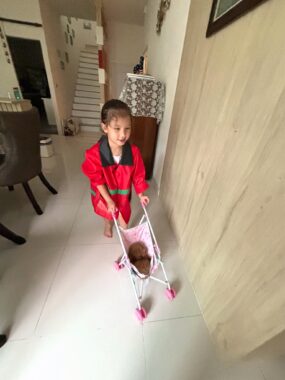A toy poodle pup is showing us the benefits of getting a dog
Daisy has worked wonders in reducing our young girl's anxiety
Written by |

After an enlightening experience at the mall — where my wife, Judy, and I witnessed the calming influence that dogs had on our 6-year-old daughter, Rylae-Ann — we found ourselves reconsidering the benefits of adding to our family. Judy and I knew we had to explore this option further to help Rylae-Ann manage her anxiety.
The decision to bring a pet into our home wasn’t made lightly. When Rylae-Ann was diagnosed with aromatic l-amino acid decarboxylase (AADC) deficiency, we were trying to navigate the new world of rare diseases. Our lives had been flipped upside down, and we were struggling to learn how to care for her debilitating symptoms. Even though we loved dogs and always wanted one for our new family, it wasn’t even in the realm of possibility at the time.
Fortunately, when Rylae-Ann was 18 months old, she had gene therapy. Over the past four years, she’s made significant progress — so much so that she requires much less care and is more independent.
Daisy chain reaction

Daisy, a toy poodle, joins the Poulin family on their journey. (Photo by Richard E. Poulin III)
When Rylae-Ann had that amazing encounter with puppies at the mall, we spent hours researching breeds, speaking with professionals, and discussing with other families in the community the impact a dog might have on our family dynamics. After careful consideration, we decided that a toy poodle would be a perfect fit for Rylae-Ann and our family.
Toy poodles are known for their intelligence, gentle nature, and hypoallergenic coats, making them an ideal choice for families with children and allergies. We didn’t have a planned day, but during a Sunday morning outing, we visited a reputable breeder “just to look and see.”
The breeder understood our daughter’s needs and helped match us with a delightful toy poodle puppy that Rylae-Ann named Daisy. Daisy had the most loving and mild temperament of the litter. She was also slightly smaller, so she wouldn’t grow to be too big. Judy and I both sensed that we’d go home with a new family member that day.
From the moment Daisy arrived home, we immediately noticed a positive change in Rylae-Ann. The bond between them was almost instantaneous. Daisy’s presence brought a sense of comfort and security to Rylae-Ann that we hadn’t seen before. Her soft fur and affectionate nature seemed to melt away the anxiety that had often troubled our daughter.

Rylae-Ann pushes Daisy around the house in a stroller to give her a tour. (Photo by Richard E. Poulin III)
Among the most significant benefits we’ve observed are the responsibility and routine that caring for Daisy has instilled in Rylae-Ann. Every morning, she eagerly wakes up to feed Daisy, and I join them for a quick walk in the yard to help the dog potty train. Rylae-Ann is responsible for filling her food and water bowls in the morning and evening. This new routine has provided Rylae-Ann with a sense of purpose and has significantly reduced her anxiety.
Daisy’s joyful and playful demeanor has encouraged Rylae-Ann to engage in more physical activities, too. For example, Rylae-Ann put her new dog in a toy stroller and pushed her around the house for a tour. They spend hours together playing and enjoying each other’s company. These activities have improved Rylae-Ann’s physical health and boosted her overall mood and well-being.
Having Daisy has also opened up new opportunities for social interaction. When Judy posted pictures on Instagram, friends and neighbors came rushing over. Rylae-Ann was extremely proud to show off her puppy. Before, being in the spotlight would’ve made her cry or run away.
In addition to the emotional and social benefits, Daisy has taught Rylae-Ann invaluable lessons in compassion and empathy. Taking care of Daisy has shown Rylae-Ann the importance of understanding and responding to the needs of another living being. We hope this newfound empathy will be extended to her interactions with classmates and friends as the new school year soon begins.
Looking back, we’re incredibly grateful for the journey that led us to Daisy. She’s brought joy, love, and stability into our lives. Most importantly, she’s become a source of comfort and support for Rylae-Ann, helping her navigate her anxiety with greater ease.
Note: AADC News is strictly a news and information website about the disease. It does not provide medical advice, diagnosis, or treatment. This content is not intended to be a substitute for professional medical advice, diagnosis, or treatment. Always seek the advice of your physician or other qualified health provider with any questions you may have regarding a medical condition. Never disregard professional medical advice or delay in seeking it because of something you have read on this website. The opinions expressed in this column are not those of AADC News or its parent company, Bionews, and are intended to spark discussion about issues pertaining to aromatic l-amino acid decarboxylase deficiency.






Alongkorn Skulareemitr
Dear, Mr.Richard E. Poulin III
My name is Alongkorn Skulareemitr
I live in Bangkok, Thailand
My son is diagnosed an AADC deficiency.
l email to you to ask for your suggestion
and consult on your experience on the therapy of AADC and how to take care of the kid
I really looking forward to hearing from you.
Thank you very much.
Best Regards
Alongkorn Skulareemitr
Cindy Gibson
This story warmed my heart! We recently lost our toy poodle, Mickey, who lived to be 17+ years. We miss him terribly but wouldn’t trade our years with him for anything. Toy poodles are the best! So smart, loving, playful and gentle. Daisy will be a great source of joy to your precious Riley Ann, as was our Mickey❤️. If we ever get another dog, it will most definitely be a toy poodle.